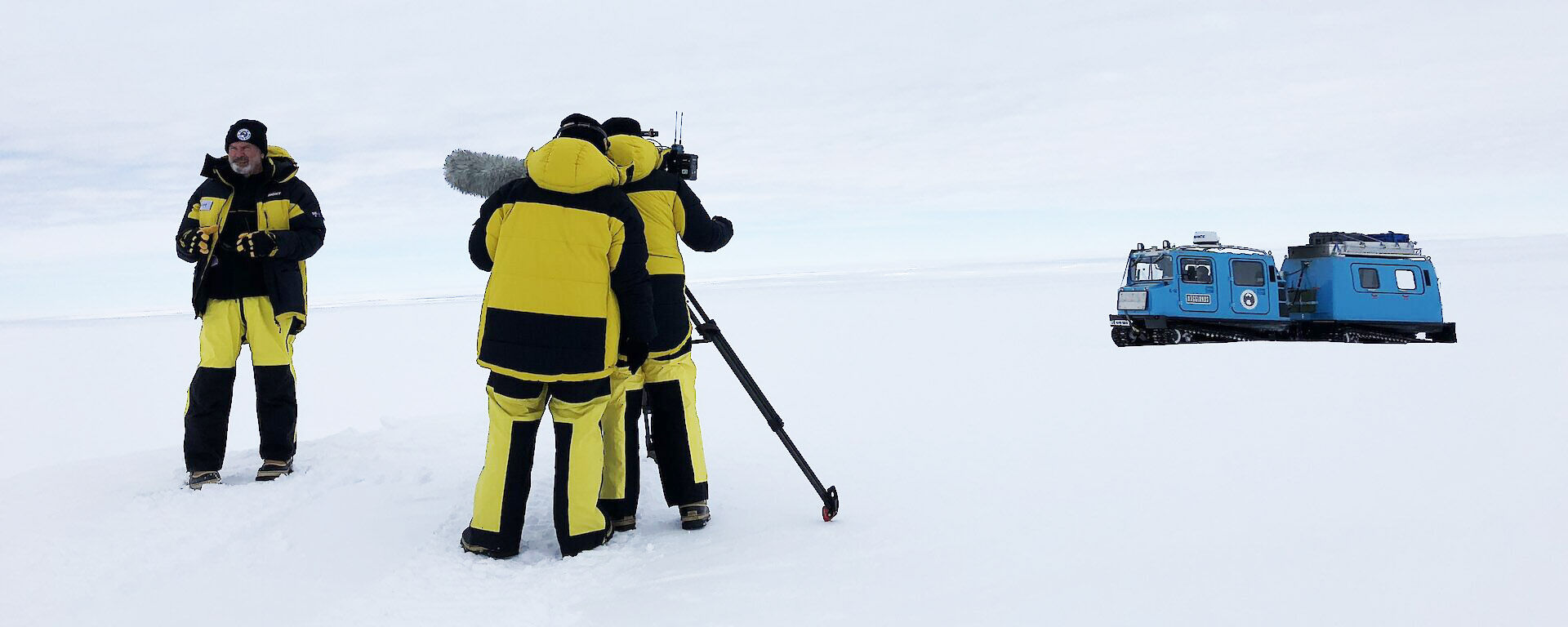Antarctic video gallery
Layered lakes in the Vestfold Hills
Video transcript
In Antarctica, biodiversity is greatest in the ice-free areas where animals and plants can live.
The Vestfold Hills is one of Antarctica’s most biodiverse regions.
An area near Davis research station is being assessed as the site for a new aerodrome.
Dr Catherine King, ecotoxicologist, Australian Antarctic Division
“So this is one of our lake transect sites. You see this lake right here? That’s one of our sampling sites. And what we’re doing in this program is looking at biodiversity across this region.”
Scientists are studying the lakes around the proposed site in unprecedented detail.
Dr Catherine King
”Importantly at Davis we have very complex lake systems and over 300 lakes of varying sizes, from small metres-squared up to several kilometres long. And the lakes in the Davis region are particularly unique because we have a range of freshwater lakes, as you’d expect, but also hypersaline or super salty lakes.”
Comparing the water and the soil between lakes will show if they are connected.
Dr Catherine King
“Our program out here is looking at a range of lakes of different sizes, different salinities. Looking at the biological communities and how diverse they are. And whether there’s any connectivity or differences between those lakes.”
Samples will be analysed in the lab for their DNA to reveal the full range of microscopic life-forms
Dr Catherine King
“That will give us a really good idea of the complexity of the communities, and whether they are similar to pockets of communities that we see elsewhere in the Vestfold Hills.”
[end transcript]
Biodiversity survey
Video transcript
Terrestrial biodiversity survey, Davis Aerodrome Project
Ecologists are searching for life in the rocky desert around Davis research station.
Dana Bergstrom, Australian Antarctic Division Ecologist “It looks very Mars-like, doesn’t it? It certainly feels like we’re in another planet, walking around this very, very abstract landscape of big boulders that have been ripped apart by thousands of years of wind.”
Dana Bergstrom “Antarctica is the end of the planetary spectrum for life. And here we’re in a very saline, desert area and as we’re still finding life. And that’s what really excites me.”
Their survey for the Davis aerodrome project is mapping where life exists.
Dana Bergstrom “So what we’re doing is we’ve modelled back in Australia the landscape, the terrain. And we found that there are ten habitat types. And what we have is a series of random points in each of those ten habitats that we need to go and visit and survey for vegetation.”
Dana Bergstrom “So by going to random points and recording what’s there, we know there there’s life or no life.”
The scientists have developed a high-tech app to guide their survey and record data from each site.
Dana Bergstrom “We have 2000 on our map. No way we’re going to get near to 2000. But we hope to go between 500 and 1000 sites.”
Dana Bergstrom “This area has been under sea in the Holocene. That’s about the last 6000 years ago. And so there’s still salt deposits here. But even in this desert, we still find life. But it’s hidden. It’s cryptic. And the place we find it, is under quartz rocks. And the reason why the quartz works but not other rocks is that light can filter through it. And here under the base you can see this amazing emerald green algae that’s growing on the rock. So the remarkable thing is that what we’re finding is that half a metre away it can be really, really salty. But under this rock is a place for life.”
[end transcript]
Nuyina’s first spin
Video transcript
ROB BRYSON: Which is about testing the propulsion system of the ship. So this is the very first stage of that.
So what we did in the beginning of this milestone is we rotated the propeller for about four revolutions over a period of about two minutes, which doesn’t sound like much, but when you think about it, the advanced electric drive was turning about 120 tonnes of high tensile steel. So that includes 43.5 tonnes of propeller plus another 80 tonnes of shaft lines.
The propulsion system is the beating heart of the vessel. That’s what actually provides the forward movement of the vessel and the power, so without a propulsion system you don’t really have a ship, and it’s just a static dumb barge. So having that working is a significant event for us and provides a lot of power for Nuyina and she’ll probably be the most powerful icebreaker in Antarctica when she goes online at the end of this year.
[end transcript]
Precision Airdrop
Video transcript
This RAAF mission to Casey station is testing new ways to resupply from the air.
Matt Filipowski, Australian Antarctic Division “The addition of low-cost chutes and precision-guided chutes is a first as we understand it, so we’re certainly for Antarctica leading the game in that space.”
WGCDR Dion Wright, RAAF Australian Southern Contingent “It offers an amazing capability, particularly a precision capability, that hasn’t been available to the Australian Antarctic Program before.”
Low-cost parachutes are cheaper and easier to recover than standard ones.
Dion Wright “They’re designed to be disposable but they can be reused again once they’re brought back.”
From 750 feet, the low-cost parachutes land the cargo accurately and intact.
From much higher altitudes, the precision system uses GPS to guide the parachute to a designated target.
Matt Filipowski “The parachute is a traditional type of parachute but it’s actually controlled by a machine that guides and pulls on the risers, as they’re called, to actually steer the parachute. It does the job of what a human usually does underneath a guided parachute.”
You can hear the guidance motors steering the parachute.
From an altitude of 10,000 feet, it lands within 30 metres of the target.
Matt Filipowski “That gives us a number of advantages — we can be further away from wildlife or completely removed, so reducing noise.”
This will be used for resupplying inland convoys or remote camps.
Dion Wright “It will enhance the ability for the ADF to contribute to Australia’s Antarctic Program, it’ll enable us to throw things out of the back of the aircraft with these systems, at the right time and the right way in a safe and efficient manner.”
[end transcript]
Australia’s proposed Antarctic aerodrome open for comment
Video transcript
The initial proposal for a new aerodrome in Antarctica is now publicly available.
Kim Ellis, Director, Australian Antarctic Division In 2016, the Australian Government launched a strategy and action plan for Antarctica and this sets a new era and a new standard for Australia’s engagement in Antarctica.
Kim Ellis “It also foreshadowed the work to develop a paved aerodrome at Davis Station.”
The proposed aerodrome will enable more ambitious science
It will provide year-round access and improve emergency response.
Kim Ellis “It will transform the science we’re able to deliver in Antarctica. At the moment we’re constrained by a very narrow summer window to get our logistics in and out and our scientists work is limited by that operational window.”
The proposal includes a 2,700 m long runway, aircraft apron, and buildings.
Scientists have been on the ground for several years to build an understanding of the site.
The project will have a high level of environmental scrutiny, nationally and internationally.
Kim Ellis “There will undoubtedly be some environmental impacts and the process we’re going through now will ensure those impacts are minimised and mitigated where possible through alternative construction methodology or changes to the design and operation of the airfield.”
Kim Ellis “Over the 60 years that Australia has been involved in Antarctica we’ve set a very high benchmark for all our activities and operations and this project is no exception.”
[end transcript]
Citizen Cool
Video transcript
This former Limerick lad has swapped the green hills of Ireland for the icy shores of Antarctica.
Michael Keating Kearney, New Australian Citizen “It feels very privileged and very unique to have my ceremony down here in Antarctica, I’m very happy its turned out to be a wonderful day.
Michael is a carpenter at Casey research station. In Australia for 9 years, he’s become an Australian citizen in the coolest way possible.
Michael Keating Kearney, New Australian Citizen “I pledge my loyalty to Australia and its people.”
Justin Ross, Deputy Station Leader “Please join me in welcoming our newest Australian citizen. This is my first citizenship ceremony, so I was understandably a little nervous, but I am immensely proud to have this opportunity to be the presiding officer for Michael’s special day.”
Michael Keating Kearney, New Australian Citizen “Living in Australia is very good, it’s a good culture, good people, the work is great. Feeling very happy, very excited and very grateful to be an Australian citizen.”
[end transcript]
NASA’s icy mission
Video transcript
This buoyant robot is on its first Antarctic mission.
Voice of NASA Scientist Dr Kevin Hand; “Almost there, almost there, now just drag it some place. You’re beneath the ice.” You’re beneath the ice.”
NASA has just returned from three weeks at Casey station testing a future space robot.
NASA Scientist Dr Kevin Hand “What this vehicle does is, it floats on the underside of the ice and allows us to inspect scientifically what’s happening.”
NASA Lead Engineer Dr Andy Klesh “Including a dissolved oxygen sensor, looking at conductivity, temperature and depth and of course video images.”
NASA Scientist Dr Kevin Hand “What we saw was just stunning, the sea-ice algae dangling down like little chandeliers, the gas bubbles under the ice. We even tested the rover on a tide fracture, a crack in the ice.” We even tested the rover on a tide fracture, a crack in the ice.”
NASA Scientist Dr Kevin Hand “We learned that from navigating some of the cracks an additional wheel, to make it more like a tricycle, could be helpful. Being able to have thrusters on it, to vary our buoyancy when needed.” Being able to have thrusters on it, to vary our buoyancy when needed.”
Eventually the robot will explore another icy landscape on one of Jupiter’s moons.
NASA Scientist Dr Kevin Hand “Now of course the dream of dreams is that someday this vehicle is sufficiently small and low power and low weight, such that we could eventually get it into and beneath the ice of Europa, where we might someday find signs of life beyond Earth.
[end transcript]


